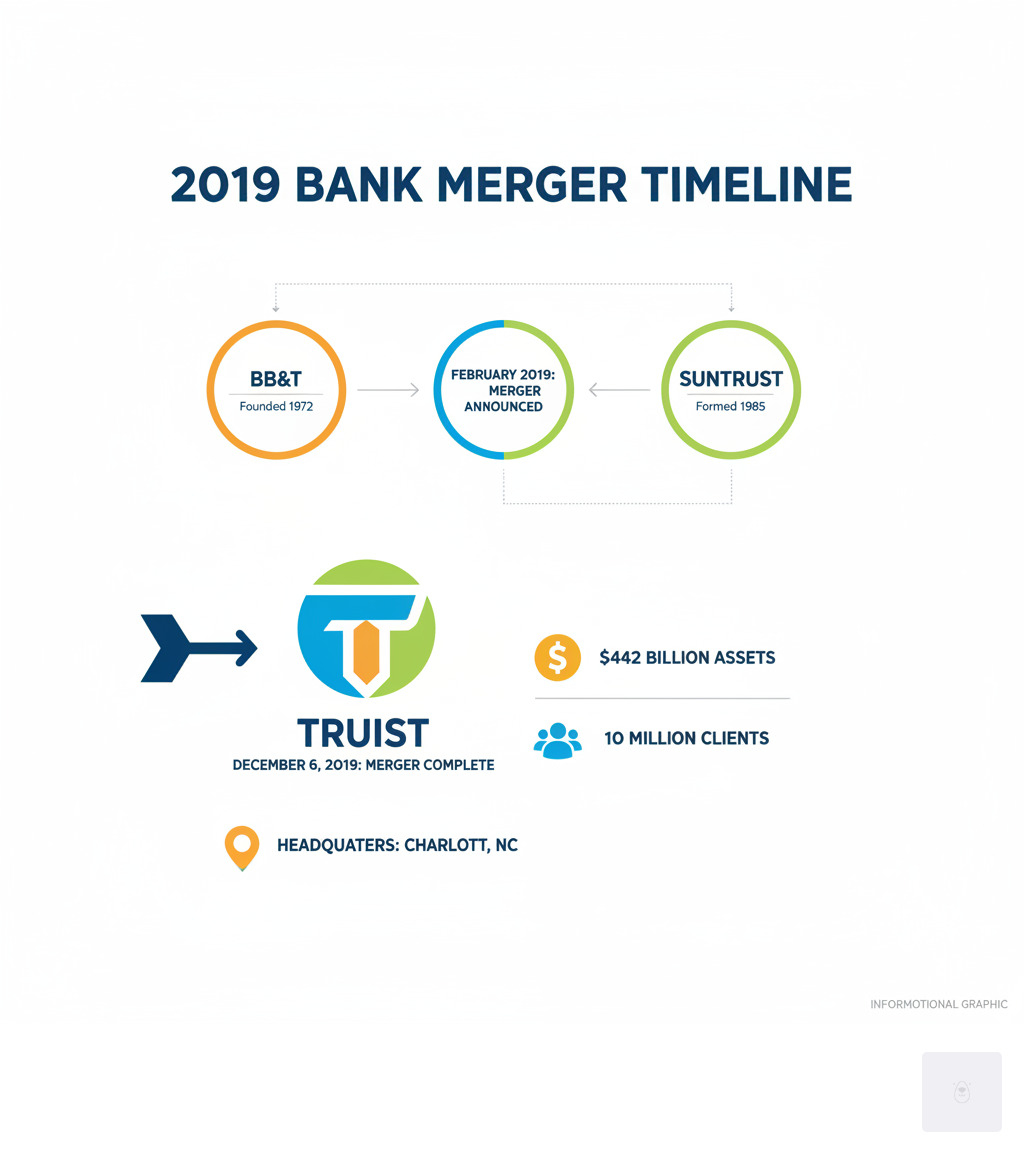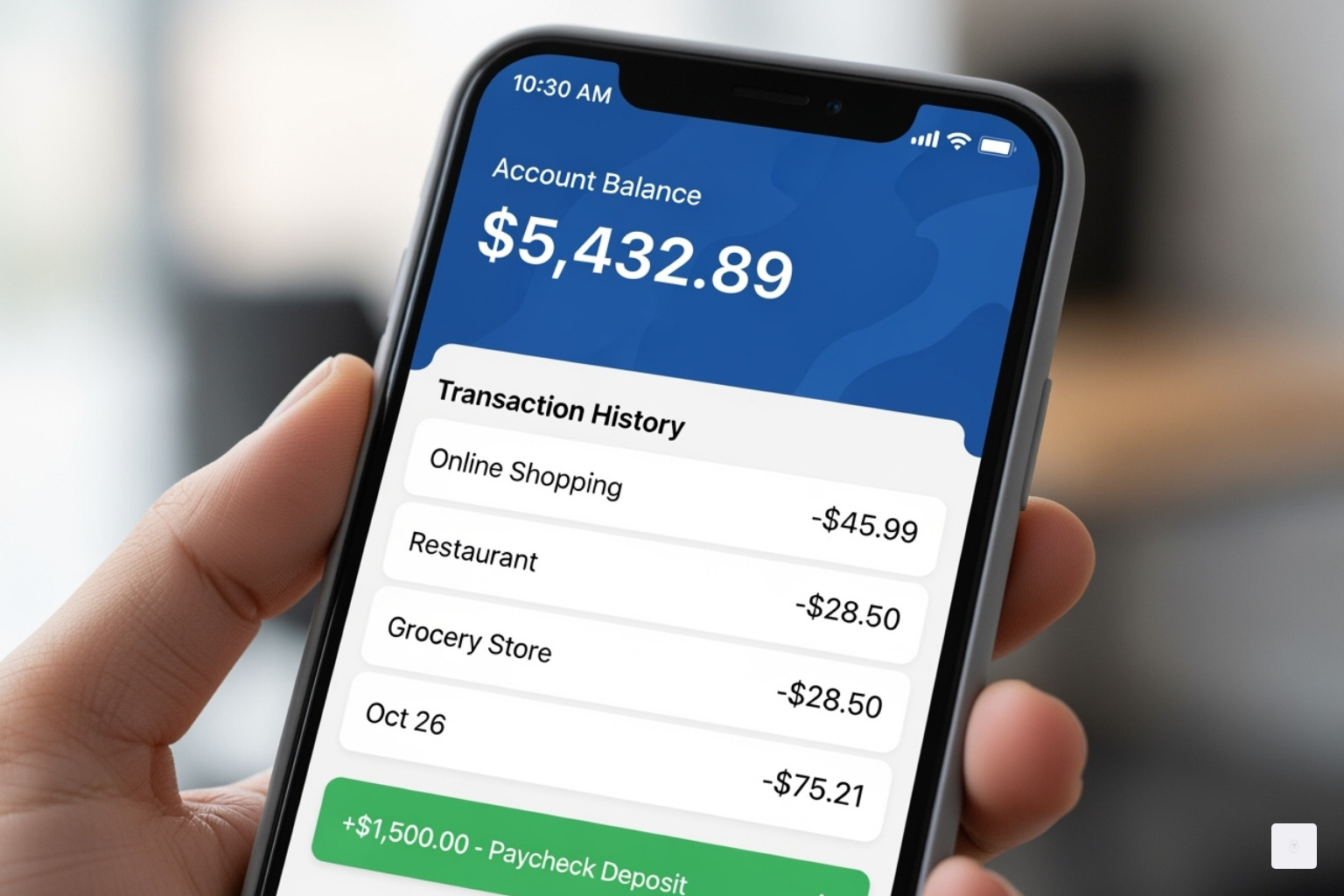
Why Understanding Truist Matters for Your Financial Future

Truist is one of America’s largest banks, formed in December 2019 when BB&T and SunTrust merged to create the sixth-largest U.S. bank. Here’s what you need to know:
- Scale: $531.2 billion in total assets, 1,928 branches across 15 states and Washington, D.C.
- Services: Consumer and commercial banking, credit cards, mortgages, wealth management, investment banking, and insurance
- Formation: Merger of equals between two century-old institutions (BB&T founded 1872, SunTrust formed 1985)
- Headquarters: Charlotte, North Carolina
- Current Rank: Tenth-largest U.S. bank by assets as of May 2025
Whether you’re a longtime customer of BB&T or SunTrust who suddenly saw the name change, or you’re simply curious about this banking giant with branches throughout New York and the greater metropolitan area, understanding Truist means grasping how modern banking consolidation creates both opportunities and challenges for sophisticated consumers.
The merger wasn’t just a corporate reshuffling—it represented a $66 billion deal that combined 10 million clients, $442 billion in assets, and decades of regional banking heritage into a single national powerhouse. Yet many customers still don’t fully understand what this change means for their day-to-day banking, their investment strategies, or their access to services in cities like New York.
As R. Couri Hay, I’ve spent over 40 years chronicling the evolution of major institutions and advising clients on navigating complex corporate landscapes, including financial services transitions like the formation of Truist. My work connects the dots between corporate strategy and personal impact for discerning professionals.

Change 1: Understand the Merger That Created a Banking Powerhouse
If you’re going to bank with Truist, you should know exactly who you’re dealing with. Think of it this way: you wouldn’t move to New York City without learning about Manhattan, Brooklyn, and the Bronx. Each borough has its own character, its own story. The same goes for Truist—it’s not just a fresh coat of paint on an old building. It’s the fusion of two banking giants, each with more than a century of history, triumphs, and yes, some difficult chapters too.
The History of BB&T and SunTrust
Let’s start with BB&T, or Branch Banking and Trust Company. Picture this: it’s 1872 in Wilson, North Carolina. Two entrepreneurs named Alpheus Branch and Thomas Jefferson Hadley open a small merchant bank. That humble beginning would eventually grow into one of the Southeast’s most respected financial institutions.
What made BB&T special? It survived when others didn’t. While countless banks collapsed during the 1929 Stock Market Crash, BB&T kept its doors open through conservative management and steady growth. The bank built its empire one strategic acquisition at a time, a pattern familiar to many in the New York area who have seen local banks change names over the years. In 1995, it merged with Southern National Bank, instantly expanding to 535 branches and 8,700 employees. When Colonial Bank failed in 2009, BB&T stepped in to acquire over 340 branches. The pattern continued with acquisitions that brought its footprint closer to New York, including Susquehanna Bank in 2015 for $2.5 billion (240 branches) and National Penn in 2016 for $1.8 billion (124 branches). BB&T also became a powerhouse in insurance services, which grew to represent a major revenue stream.
Now let’s talk about SunTrust Banks. While the SunTrust name officially appeared in 1985 through the merger of Trust Company of Georgia and Sun Banks Inc., its story reaches back to 1891. Trust Company of Georgia wasn’t just a bank—it was instrumental in building Atlanta and developing the entire Southeast economy. Sun Banks Inc. brought its own impressive legacy, particularly its dominance in Florida banking markets.
Here’s something important: both BB&T and SunTrust have complicated histories. Like many institutions that have been around for over a century, they existed during America’s darkest chapters. Truist has publicly acknowledged that BB&T had connections to businesses that profited from slavery. The bank’s current leadership has issued clear statements condemning racial injustice and expressing genuine regret for these historical ties. You can read their full commitment on the “Acknowledging Our History” page. It’s not comfortable history, but it’s honest history—and that matters.
The Formation of Truist
When BB&T and SunTrust announced their merger in February 2019, the financial world paid attention. This wasn’t just another acquisition—it was billed as a “merger of equals,” a $66 billion deal that would create the sixth-largest bank in the United States. The merger officially closed on December 6, 2019, bringing together 10 million clients and $442 billion in combined assets.
The new name sparked plenty of conversation. Social media had a field day with “Truist,” and let’s be honest—it took some getting used to. But the name came from serious research, including employee surveys and focus groups across both organizations. The logo features two T’s representing “touch and technology,” and the purple color scheme cleverly blends SunTrust’s blue with BB&T’s burgundy. The headquarters landed in Charlotte, North Carolina, at the Truist Center (formerly the Hearst Tower), establishing a central command for the entire operation.
Fast forward to today, and Truist has proven itself as a major player. As of May 2025, it ranks as the tenth-largest U.S. bank by assets, holding $523 billion. In 2024, the bank reported $24.25 billion in revenue, $4.84 billion in net income, and total assets of $531.2 billion, all managed by 38,335 employees. The bank operates approximately 1,928 branches and over 2,900 ATMs across 15 states and Washington, D.C.—including locations serving New York City and the surrounding metro area. For those who want the full financial picture, check out the “Truist Financial Corporation 2024 Annual Report (Form 10-K)”.
When the merger completed in December 2019, Truist immediately commanded impressive numbers: $442 billion in total assets, 10 million clients, $301 billion in total loans, and $324 billion in total deposits. That sixth-place ranking among U.S. banks wasn’t just for show—it represented real scale and capability that continues to benefit customers today.
Understanding this merger history isn’t just trivia. It explains why Truist offers such a comprehensive range of services, why it has such deep roots in the Southeast while also serving major markets like New York, and why it’s positioned to compete with the absolute biggest names in banking. You’re not dealing with a startup or a regional player—you’re working with an institution built on 150 years of combined banking experience.
Change 2: Leverage the Digital-First Truist Experience
Here in New York City, we know that time is precious. Whether you’re navigating the subway to a meeting in Midtown or managing your business from a coffee shop in Brooklyn, you need banking that moves as fast as you do. That’s where Truist truly shines—not just in its physical presence across the state, but in its commitment to bringing sophisticated financial services right to your smartphone.
While Truist maintains an impressive network of 1,928 branches across 15 states and Washington, D.C., including locations accessible to New Yorkers, the bank has made strategic investments in digital technology that transform how we interact with our money. This isn’t just about convenience—it’s about giving us control, transparency, and flexibility in managing our financial lives from anywhere in the city or beyond.

Key Products for Consumers and Businesses
Let me walk you through what Truist offers, because understanding your options is the first step to making smart financial decisions.
For those of us managing personal finances, the Truist One Checking account stands out as a genuinely consumer-friendly product. No overdraft fees—yes, you read that right. This account eliminates one of the most frustrating aspects of traditional banking and includes automatic upgrades for eligible clients. It’s the kind of thoughtful design that shows a bank is actually listening to what people need.
Looking to grow your savings? The Truist One Money Market Account provides a competitive option for building your reserves without locking your money away. And if you’re managing larger expenses—whether that’s consolidating debt, renovating your home, or funding a significant life event—LightStream offers unsecured loans with competitive rates. Some credit products even feature introductory variable rates as low as Prime minus 1.51% APR for the first nine months.
Truist also offers a solid range of credit cards custom to different priorities, whether you’re chasing cash back rewards, travel points, or simply seeking a low APR. For homeowners, a Home Equity Line of Credit (HELOC) can open up the value you’ve built in your property for major projects or investments.
Business owners in New York have equally compelling options. The Small Business Money Market Account offers attractive annual percentage yields—some eligible clients can access rates around 3.50%—helping your cash reserves work harder for you. Beyond that, Truist provides comprehensive commercial banking solutions including lending, treasury management, and customized financial strategies for growing companies.
Just as we emphasize clear, consistent messaging in our branding services, Truist has built its identity around “care” as a core principle, aiming to foster genuine trust with customers.
Mastering the Truist App in NYC
The Truist mobile app is where digital banking truly comes alive for New Yorkers. Think of it as your personal banker that fits in your pocket—available 24/7, whether you’re catching a cab or grabbing lunch in the Financial District.
Account management becomes effortless when you can check balances, review transaction histories, and customize your account view in seconds. You can even reorder accounts so the ones you use most frequently appear first. It’s the kind of small detail that makes daily banking feel less like a chore and more like having everything exactly where you want it.
Mobile check deposit eliminates those inconvenient trips to a branch. Just snap a photo of your check, submit it through the app, and move on with your day. No more hunting for a branch location or adjusting your schedule around banking hours.
Sending money through Zelle is remarkably simple—perfect for splitting dinner bills with friends, paying your share of rent to a roommate, or settling up with your dog walker. Just keep in mind that Zelle payments are typically immediate and irreversible, so double-check the recipient before sending.
The bill pay feature centralizes all your payments in one secure location, helping you avoid late fees and maintain excellent credit. For those of us juggling multiple obligations, this kind of organization is invaluable.
Card management through the app offers real peace of mind. Misplaced your debit card somewhere between Penn Station and your office? Lock it instantly through the app. Found it in your other bag? Open up it just as quickly. You can also set spending limits and regional restrictions, adding an extra layer of security when you’re traveling or just want tighter control over your accounts.
Transferring money between your Truist accounts is instant and seamless. You can also link external accounts at other U.S. financial institutions for transfers, though fees may apply. This flexibility means you’re never locked into a single institution—you can move money where you need it, when you need it.
What truly sets the app apart are its budgeting and financial insights. By linking all your accounts—even those at other banks—you get a complete picture of your financial health. The app analyzes your spending patterns, shows you trends and cash flow, and helps you set realistic budgets and savings goals. For those of us trying to build wealth in one of the world’s most expensive cities, these tools can be genuinely transformative.
Security features include Face ID and Touch ID for quick, secure access, plus an improved Security Center checklist to strengthen your account protection. You can review your sign-in history and see which devices have remembered your login information, giving you complete visibility into who’s accessing your accounts.
Need to find an ATM while you’re out in Manhattan or visiting friends in Queens? The app’s location finder shows you nearby Truist branches and ATMs, with over 2,900 ATMs in the network. You can even schedule appointments with customer support directly through the app, ensuring you get expert help exactly when you need it.
By embracing these digital tools, we New Yorkers can bank on our own terms—efficiently, securely, and with the kind of control that makes managing money feel less overwhelming and more empowering.
Change 3: Engage with the Bank’s Broader Culture and Impact
When we choose where to bank, we’re not just selecting a place to stash our money. We’re entering into a relationship with an institution that has values, a voice, and a presence in our communities. Understanding Truist means looking beyond the checking accounts and mortgage rates to see what kind of corporate citizen it aspires to be. Just as we New Yorkers take pride in our city’s cultural institutions and community initiatives, it’s worth knowing how the banks we trust are showing up in the world.
Leadership and Corporate Responsibility
Truist is led by Chairman and CEO Bill Rogers, who guides the company with a clearly stated purpose: “to inspire and build better lives and communities.” Now, we’ve all heard corporate mission statements that sound impressive but don’t translate into real action. What matters is how that purpose shows up in practice.
One tangible expression of this commitment is the Truist Foundation, launched in February 2020. The Foundation isn’t trying to be all things to all people. Instead, it has focused its grantmaking strategy on two specific areas: strengthening small businesses and building career pathways. The goal is economic mobility—helping people move up the economic ladder through real opportunities. For those of us in New York who understand the challenges of starting a business or building a career in an expensive city, this kind of targeted support can make a genuine difference in people’s lives.
Perhaps the most significant aspect of Truist‘s corporate responsibility journey has been its willingness to confront uncomfortable truths about its history. As we discussed earlier, Truist has publicly acknowledged that its predecessor, BB&T, had historical ties to businesses that benefited from slavery. This isn’t easy territory for any institution to steer, but the leadership has taken responsibility. Former CEO Kelly King expressed deep regret for these historical connections and committed to “do everything I can to make it better.” The bank has issued formal statements condemning racial injustice and continues to address this legacy through its “Acknowledging Our History” page.
This kind of transparency and accountability matters. It shows an institution willing to examine its past honestly while working to create a more equitable future. For customers who care about corporate ethics and social responsibility, these actions speak volumes about Truist‘s character.
High-Profile Sponsorships and Naming Rights
You’ve probably seen the Truist name even if you’ve never walked into one of their branches. The bank has strategically invested in naming rights and sponsorships across the country, particularly in sports and entertainment venues. This isn’t just about slapping a logo on a building—it’s about becoming part of the cultural fabric of the communities they serve.
Truist Park is perhaps the most recognizable, serving as home to the Atlanta Braves Major League Baseball team. But the bank’s reach extends far beyond Atlanta. Truist Field hosts the Charlotte Knights, while Truist Stadium serves both Winston-Salem and North Carolina A&T State University. College sports fans might recognize Truist Arena at Northern Kentucky University or Truist Point in High Point, North Carolina. And for golf enthusiasts, there’s The Truist Championship on the PGA Tour.
These sponsorships do more than build brand awareness. They connect Truist to the passions and pastimes that bring communities together—whether that’s cheering for a local team, supporting college athletics, or following professional golf. For a bank that’s only been around since 2019, these high-profile partnerships help establish its presence and credibility quickly.
While New York City itself doesn’t currently have a major Truist-branded venue, the bank’s commitment to community engagement through sports and culture reflects a broader philosophy about how financial institutions can contribute to the places they serve. It’s a reminder that banking isn’t just transactional—it’s relational, and the best institutions understand that building strong communities ultimately benefits everyone, from individual account holders to business clients to the bank itself.
Frequently Asked Questions about Truist
What is Truist and how was it formed?
If you’ve been banking in New York City or anywhere along the East Coast and suddenly noticed your BB&T or SunTrust branch sporting a new purple logo, you’re not alone in wondering what happened. Truist Financial Corporation is a major U.S. bank holding company that emerged on December 6, 2019, when two century-old regional banking institutions—BB&T (Branch Banking and Trust Company) and SunTrust Banks—joined forces in what they called a “merger of equals.”
This wasn’t just any merger. The $66 billion deal instantly created the sixth-largest bank in the United States, bringing together 10 million clients and $442 billion in assets under one roof. The new headquarters landed in Charlotte, North Carolina, though the bank’s reach extends far beyond the Carolinas, serving customers throughout New York and across 15 states and Washington, D.C.
Today, Truist continues to rank among the largest banks in the country, now standing as the tenth-largest by assets with $531.2 billion as of May 2025. For those of us who remember when community banks had distinct regional personalities, Truist represents the modern era of banking consolidation—bigger, more technologically sophisticated, but still aiming to maintain that personal touch.
What are the main services Truist offers?
Truist operates as a full-service financial institution, which means whether you’re a freelance artist in Brooklyn managing irregular income or a business owner in Manhattan expanding your operations, there’s likely a product designed for your needs.
For individual consumers, the bank offers Truist One Checking—notable for its no overdraft fees policy, which is a welcome relief in expensive cities like New York. You’ll also find money market accounts for growing your savings, various credit cards offering everything from cash back to travel rewards, and personal loans through their LightStream division for consolidating debt or funding major purchases. Mortgages and home equity lines of credit round out the consumer offerings, helping New Yorkers steer the challenging real estate market.
On the business side, Truist provides small business banking solutions, commercial banking services, and specialized lending options. The bank also handles wealth management, investment banking, securities brokerage, asset management, and insurance products through its various divisions. It’s essentially a one-stop shop for financial services, whether you’re managing your household budget or running a growing enterprise.
How many branches does Truist have?
As of 2024, Truist operates approximately 1,928 branches spread across 15 states and Washington, D.C., supported by a network of over 2,900 ATMs. For those of us in the New York City metro area, this means you have access to physical locations when you need face-to-face service, though the exact number of local branches reflects the bank’s stronger presence in the Southeast.
The merger naturally involved some branch consolidation—when two banks combine, some overlap is inevitable. However, Truist has maintained a significant physical footprint to complement its robust digital banking platform. This dual approach means you can deposit that check via your phone while riding the subway, but still walk into a branch in New York when you need to discuss more complex financial matters like a mortgage or business loan. It’s the best of both worlds for customers who value flexibility in how they bank.
Conclusion
So here we are at the end of our journey through Truist—from its impressive merger origins to its digital-first approach and community commitments. If you’ve made it this far, you now know more about this banking giant than most of its customers do, and that knowledge is genuinely valuable.
Understanding Truist isn’t just about memorizing facts and figures. It’s about recognizing how this institution can fit into your life, whether you’re managing your personal finances from a Brooklyn brownstone or running a business in Manhattan. The bank’s evolution from two century-old Southern institutions into a modern, tech-savvy financial powerhouse tells us something important: banking is changing, and those who understand these changes are better positioned to benefit from them.
The three key insights we’ve explored—the merger’s historical significance, the digital tools at your fingertips, and the bank’s broader cultural impact—give you a complete picture. You’re no longer just a customer; you’re an informed partner in your financial journey. You know where Truist came from, what it offers today, and what it stands for as a corporate citizen.
For those of us here in New York City, this matters. While Truist may not have the same massive physical footprint as some regional banks, its digital capabilities mean location matters less than it used to. You can access world-class banking services from your phone while grabbing coffee in the Village, just as easily as someone visiting a branch in Charlotte.
Truist represents a significant chapter in American banking history, and now you’re equipped to make the most of what it offers. That’s financial empowerment in action, and it’s something we can all celebrate.
For more insights on navigating the modern landscape of business, culture, and society, explore more R. Couri Hay Columns.

